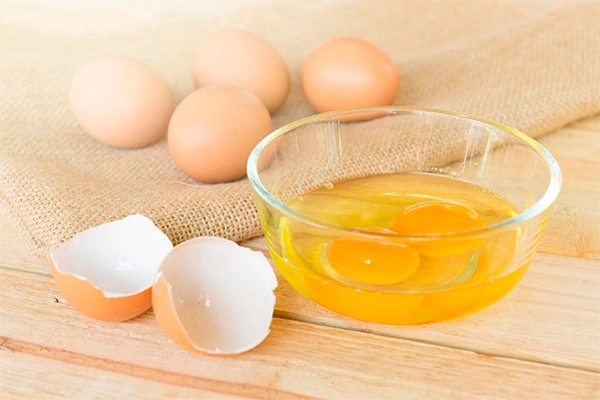Calves, mimosa, boiled, poached, scrambled, casseroles, fried… Eggs are one of the most versatile and nutritious foods you can find. They are an excellent source of high-quality protein, essential vitamins and minerals. Not only are they delicious, but they also offer many health benefits.
A subtle nutritional balance
Inexpensive, eggs are consumed around the world and are among the most nutritious foods. Originally, the egg exists to nourish the bird in its embryonic state. An egg has between 70 and 80 calories for around 50g and 5 to 6g of high quality protein.
The nutritional value of the egg lies in the subtle balance and diversity of its constituents: some of the best proteins, very good quality lipids, numerous vitamins and minerals. Its rich and varied composition makes it one of the favorite foods of nutritionists. Moreover, for breakfast, an egg has a greater appetite suppressant effect than a piece of bread, a croissant or even a bowl of cereal!
Proteins distributed equally between the yolk and the white
Proteins are essential to our body: for the functioning of muscles, energy supply, stimulation of the immune system or even for the cardiovascular and hormonal systems. In the egg, the proteins are distributed in large quantities and equally in the white and the yolk. It is estimated that two eggs provide as much protein as 100g of meat or fish. In addition, these are rich in essential amino acids in balanced proportions relative to our needs.
A supply of essential vitamins and minerals
Eggs are rich in essential vitamins such as vitamin B12, vitamin D, vitamin A, vitamin E and vitamin K. Vitamin B12 is particularly important for maintaining normal energy metabolism, for the functioning of the immune system, for the health of the nervous system, psychological functions and the production of red blood cells. Vitamin D is essential for calcium absorption and maintaining bone health. Vitamins A, E and K are powerful antioxidants that play a crucial role in protecting cells from damage caused by free radicals.
Eggs are also a very good source of essential minerals such as iron, zinc, selenium and phosphorus:
- Iron is needed to carry oxygen throughout the body and prevent anemia. A 50g egg contains approximately 0.7 mg of iron.
- Zinc plays a key role in immune function, wound healing and reproductive health.
- Selenium is an antioxidant that supports thyroid function and helps prevent cell damage. A 50g egg contains around 15 mg of selenium.
- Phosphorus is important for bone and dental health, as well as energy metabolism. A 50g egg contains approximately 86 mg of phosphorus.
Eggs: allies of eye health
Eggs contain natural carotenoids such as lutein and zeaxanthin. They are beneficial for eye health. These compounds may help reduce the risk of age-related eye diseases, such as macular degeneration and cataracts. Lutein and zeaxanthin help protect the eyes from free radical damage and filter potentially harmful blue light.
Weight and appetite control
Eggs can be a valuable ally in weight management. At breakfast time, their high protein content helps increase the feeling of fullness and reduce cravings. Overall caloric intake can thus be limited. Additionally, eggs are low in calories and high in nutrients, making them a satisfying choice as part of a balanced diet. The protein found in eggs also boosts metabolism, which can promote fat burning and the preservation of lean muscle mass.
Additionally, eggs are a source of healthy fats, including essential fatty acids such as omega-3. These fatty acids support cardiovascular health by reducing triglyceride levels and improving the ratio of good cholesterol (HDL) to bad cholesterol (LDL). It’s important to note that most of the fat in eggs is found in the yolk, so it’s recommended to consume the whole egg to benefit from all the nutrients. On the other hand, be vigorous about the selection of your eggs and their origin. Poor quality eggs are, on the contrary, richer in omega-6 than in omega-3 and therefore further promote weight gain. Try not to exceed 2 eggs per day.
So, incorporating eggs into your diet can have positive effects on weight and appetite management. Their high protein content, low calorie intake and rich nutrient content make them a nourishing, filling and satisfying choice.

Misconception about eggs and cholesterol
The egg, naturally rich in cholesterol, has long been accused of increasing blood cholesterol levels, a message delivered in the 1980s which caused its consumption to drop by almost 25%.
However, according to INRA, most studies carried out after this indictment have demonstrated that there is no link between a high daily consumption of eggs (up to 3 per day) and the influence on cholesterol levels in humans (for nearly 95% of the population). There would therefore be no negative impact on the risk of cardiovascular diseases.
How to eat eggs?
Ideal cooking and storage
In its raw state, egg proteins are only half digested (no offense to Rocky Balboa) while after cooking, their digestion is almost complete. Conversely, if the yolk is overcooked, the proteins are less well digested. The ideal is therefore to eat a poached or soft-boiled egg rather than a hard-boiled egg.
By keeping it in the refrigerator or in a cool place away from humidity, the egg is considered extra fresh for up to 9 days after laying and fresh for up to 28 days. To avoid any contamination, it is also important to ensure that the shell is intact (absence of micro-cracks).
If you want to test the freshness of your egg, immerse it in a glass filled with water. If it sinks: it is fresh, if it floats: it is no longer really!
Egg labeling
There are different categories of eggs:
- Category A: premium quality eggs, “fresh eggs” intended for human consumption with weight categories: XL, L, M, S (reference size in cooking). These eggs also carry a number linked to the type of breeding from which they come: hens raised outdoors, their diet meets organic farming standards (n°0); chickens with a grassy area of at least 2.5 m² (n°1-open air); hens raised free on the ground in an enclosed building of one m² for 7 hens (no. 2) and hens raised in cages (no. 3).
- Grade B: Grade B eggs are eggs that do not meet the same quality standards as Grade A eggs. They may have minor defects such as lightly stained shells, small cracks or cosmetic imperfections. These eggs are always clean, safe for consumption and they retain their nutritional value. However, they are typically used in the food industry to make processed products such as pastries, sauces or prepared meals, rather than being sold directly to consumers.
- Grade C: Grade C eggs are eggs that do not meet the quality standards for Grade A and B eggs. They may have more pronounced defects, such as cracked or dirty shells. These eggs are generally not intended for direct consumption and are mainly used in the food industry for the production of ingredients or processed foods.

Eggs and labels
The Red Label
The Label Rouge for eggs guarantees superior quality standards and animal-friendly breeding. The chickens are fed specific foods, raised outdoors, and provided with adequate space. Regular checks are carried out to ensure compliance with the label’s requirements.
The AB label
Organic eggs come from free-range or free-range hens, which are fed an organic diet without pesticides and chemical fertilizers. These chickens are also raised without antibiotics or growth hormones. Organic eggs are often recognizable by their label or packaging bearing the words “organic” or an organic certification logo.
Free-range eggs
Free-range eggs come from hens that have access to the outdoors to move freely and scratch the ground. They are generally housed in buildings with access to grassy outdoor spaces. The packaging of these eggs may carry statements such as “free-range” or “free-range eggs”.
Enriched eggs
Some eggs are enriched with specific nutrients to meet specific nutritional needs. For example, there are eggs enriched with omega-3, which come from hens fed a special diet rich in omega-3 fatty acids. These eggs may be identified by labels or packaging with statements such as “enriched with omega-3”. The “Bleu-Blanc-Cœur” label guarantees eggs rich in omega-3.
You may like: Chia Seeds Vs. Flax Seeds: Nutrition, Benefits & How To Uses

Eggs in all their forms: 3 balanced recipes to delight you
To treat you, here are 3 ideas for balanced and delicious recipes whose star ingredient is eggs.
1- Fried eggs on a bed of spinach and mushrooms for 2 people
Ingredients:
- 4 eggs
- 200 g fresh spinach
- 150 g sliced mushrooms
- 1 tablespoon of olive oil
- Salt and pepper to taste
Preparation:
- Heat the olive oil in a frying pan over medium heat. Add the mushrooms and sauté for a few minutes until tender.
- Add the spinach to the pan and cook until it wilts.
- Crack your eggs into a pan of boiling water and let them poach for 4 minutes over high heat. Make sure the yolk is still runny and not overcooked.
- Meanwhile, arrange the spinach and mushroom mixture on serving plates.
- Using a slotted spoon, remove the eggs from the water and drain them slightly before placing them on the bed of spinach and mushrooms.
- Season with salt and pepper, and serve immediately.
2- Omelette with vegetables and goat cheese for 2 people
Ingredients:
- 4 eggs
- 1 red pepper, diced
- 1 medium onion, chopped
- 1 zucchini, diced
- 100 g sliced mushrooms
- 1 small log of fresh goat’s cheese
- 1 branch of spring onion
- 2 tablespoons of olive oil
- Salt and pepper to taste
Preparation:
- Heat the olive oil in a frying pan over medium heat. Add the onion and fry until translucent.
- Add the vegetables (peppers, zucchini, mushrooms) to the pan and cook until tender.
- In a bowl, beat the eggs with salt and pepper.
- Pour the beaten eggs into the pan with the vegetables.
- Cook over medium heat until the omelette is set around the edges.
- Add a few pieces of fresh goat cheese to the omelette and cook for a few more minutes until the cheese melts.
- Fold the omelette in half and serve it hot.
3- Chocolate mousse for 6 people
Ingredients:
- 4 eggs
- 200g dark chocolate
- 2 tablespoons of sugar
- 1 pinch of salt
Preparation:
- Separate the egg whites from the yolks. Place the egg whites in a clean bowl and reserve the egg yolks in another bowl.
- Melt the chocolate in a bain-marie or in the microwave.
- Add the egg yolks to the melted chocolate and mix well.
- In the bowl with the egg whites, add a pinch of salt and beat them until stiff. Gradually add the sugar, continuing to beat until the egg whites are firm.
- Gently incorporate the beaten egg whites into the chocolate mixture, folding gently to preserve the lightness of the mousse.
- Divide the mousse into individual cups or a large bowl and place in the refrigerator for at least 2 hours, until well set.
- Serve the chocolate mousse cold, possibly garnished with chocolate shavings or fresh fruit.
There you go, you are now knowledgeable about eggs and their benefits. All you have to do is enjoy yourself while taking care of your health!





